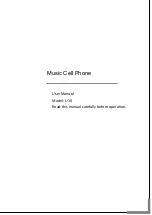
- 47 -
ZYCOO CooVox T-series IP Phone System Admin User Guide v4.0.0
l
From User
: Username to use in “From” header for sending outbound call requests to this trunk.
l
From Domain
: Your service provider’s domain name.
l
DTMF Mode
: Used to inform the system how to detect the DTMF key press. Choices are Inband, rfc4733, SIP
info and Auto.
l
Send PAI
: Send the P Asserted Identity header. The P-Asserted-Identity contains the caller id information for
the call on the INVITE SIP packet.PAI and RPID are mutually exclusive you can set one or the other but not
both.
l
RTP Timeout
: RTP Timeout can be used to automatically hangup the call if not RTP traffic is received within
60 (default) seconds.
l
Qualify
: Qualify will cause the server sending SIP OPTIONS command regularly to check that the device is still
online.
l
NAT Support
: With this option enabled, Asterisk may override the address/port information specified in the
SIP/SDP messages, and use the information (sender address) supplied by the network stack instead. This
feature is often required when there is a firewall located between the PBX and the service provider.
l
Transport Protocol
: To set the VoIP trunk to use UDP, TCP or TLS as the transport protocol, in most cases the
providers use UDP as default transport protocol.
l
Prompts Language
: You can choose a desired language of the system voice prompts to play for the incoming
calls from this trunk. For example, if the call is not answered or the user is busy, the IPPBX system will notify
the caller to leave a voice message in the language you set.
l
Simultaneous Calls
: This option will limit the number of simultaneous outbound calls can be made through
this trunk, leave it blank as not limited.
l
Preferred Outbound CID
: To set preferred outbound CID of this trunk of the extensions.
l
Outbound CID
: The number you want to display to the called party while dialing out through this trunk. It
depends on the service provider whether it works or not.
l
Dial Permission
: Custom dial permission for this trunk, by default it uses the “default” dial permission.
Configure only if this trunk is for branch office integration, so calls coming from the other side can dial out
from this IPPBX trunk directly. DO NOT change unless you fully understand how this feature works.
l
Video Codecs
: If the ITSP supports video calls then you can enable compatible video codecs here for video
phone calls.
l
Send RPID
: Send the Remote Party ID header. PAI and RPID are mutually exclusive you can set one or the
other but not both.
l
Available Codec
: CooVox IPPBX system supportsthe following audio codecs G.711 (ulaw, alaw), G.722, G.726,
G.729, GSM, Opus and Speex. You may choose the appropriate audio codecs from here and click to add to
Selected Codec.
l
Selected Codec
: Audio codecs you chose will be added here. The sequence of the audio codecs listed here is
the sequence of the audio codecs to be used for negotiating the media of a phone call to be established.
IAX Trunks
Path:
Telephony -> Outbound Control -> Trunks
IAX trunks can be used to interconnect 2 IPPBXs in remote locations. You have to create a “Server Mode” IAX trunk
on one IPPBX and a “Client Mode” on the other IPPBX. The server mode IAX trunk should define username and
password, the username and password should be applied on the client mode IAX trunk.
Summary of Contents for CooVox T Series
Page 1: ...Software version v3 0 2 ...
















































